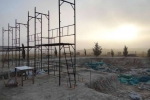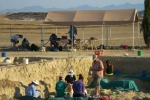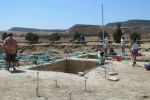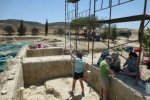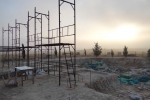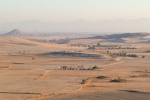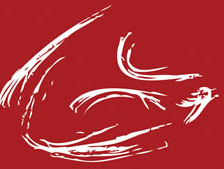Archaeological Sites
Indisputable witness of Hellenism in the region, from which later came the current community are the Greek settlements surrounding the Municipality of Athienou.
Archaeological site of the ancient city of ‘‘Golgoi’’.
It is now widely accepted that it was built around Athienou. Theocritos (Greek poet) was the first to mention Golgoi, in his idyll «Syracuse or Adoniazousai ‘, in 275 BC. Many other authors mentioned Golgoi such as Pausanias, Katoulas and Plinios with the tonic accent on the ending syllable. There are two versions in ancient literature sources about the establishment and designation of the city of Golgoi, that have been preserved until today:
(A) Sikyonian colonists with their leader Golgo founded the city. Sikyonia is an ancient town of Peloponnese and capital of the region of Sikyonia near Corinth. (The up to date archaeological data do not confirm nor deny this tradition).
(B) The second tradition says that the city was named after ‘‘Golgos’’, son of Venus (Aphrodite) and Adonis.
Athanasios Sakelarios in 1851 was the first Greek scholar who coidentified the ancient name Golgoi with the archaeological site that exists northeast of Athienou.
This location is known as ‘‘Giorkoi’’ and although in 1851 Athanasios Sakelarios found some domestic architectural remains, he found no traces of the temple of Aphrodite which intrigued him.
In 1918 M. Markides found in Arsos, five miles northeast of Athienou, inscriptions referring to Aphrodite which confirmed the coidentity of the locations ‘‘Giorkoi’’ and ‘‘Golgoi’’
From 1867 until 1870 Luigi Palma di Cesnola engaged in excavation activities around ancient Golgoi, with the sole purpose of finding archaeological treasures. He amateurly excavated at various sites around Athienou, particularly in the location of Saint Fotios, about three kilometers east of the village. Information on the topography of the area where Luigi Palma di Cesnola acted is given by Mr. O. Masson. The whole area suffered dreadful consequences.
The visible until then ruins of the ancient city were destroyed not only by the work of the US consul in Larnaca, Luigi Palma di Cesnola, but also from excavations from other foreign and local individuals.
Luigi Palma di Cesnola, found and excavated many intact tombs of the cemetery in the ancient city and two holy mosques from which he found numerous pottery, 32 clay statues and figurines, plus several limestone and marble heads of other statues. Most of these findings are exhibited in the Metropolitan Museum in New York.
Between 1969 and 1972 the Greek archaeological mission of the University of Thessaloniki, under the coordination of Professor G. Bakalaki engaged in systematic excavations at the site of Giorkoi.
Archaeological site of Malloura
Since 1990 archaeological excavations are conducted at the site of Malloura south of Athienou, from an American mission (Athienou Archaeological Project) under the supervision of Dr. Michael K. Toumazou, Professor of Archeology at Davidson College, North Carolina in America.
The work of the archaeological mission is an interdisciplinary program which focuses on the archaeological site of Athienou – Malloura and the surrounding valley in south-central Cyprus.
The Malloura site is located about 6 km southwest of Athienou.
Sponsors of the Athienou Archaeological Project are the Davidson College of North Carolina in America, the National Science Foundation of America, the Dumbarton Oaks Foundation and supported by the Municipality of Athienou.
The excavations have brought to light important archaeological finds:
(A) two cemeteries (one from the Archaic to the Roman period and the other from the Venetian)
(B) a settlement (from the Roman to Ottoman Period) and
(C) a sanctuary of male gods (from the Archaic to the Roman period) (Apollo, Hercules, Pan etc.)
The more than two thousand objects (including gold) exhibited in the Larnaka District Museum along with thousands of other artifacts from the Ancient city of Golgoi decorating showcases in various museums of Europe and the United States, reveal the rich archaeological heritage of the area.
For more information, visit the web address: http://aap.toumazou.org/ , https://www.davidson.edu/academics/classics/faculty-and-staff/michael-toumazou
